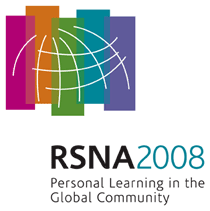
Abstract Archives of the RSNA, 2008
SSM09-06
Noninvasive Diagnosis and Quantitative Assessment of Fatty Liver Disease: A Prospective Comparison of Ultrasonography, CT, Dual Gradient Echo MR, and Single-voxel MR Spectroscopy with Same-day Biopsy as a Reference Standard
Scientific Papers
Presented on December 3, 2008
Presented as part of SSM09: Gastrointestinal (Liver: Fatty Liver)
Seung Soo Lee MD, Presenter: Nothing to Disclose
Seong Ho Park MD, Abstract Co-Author: Nothing to Disclose
Eun Sil Yu MD, Abstract Co-Author: Nothing to Disclose
Dae Yoon Kim, Abstract Co-Author: Nothing to Disclose
Hye Jin Kim MD, Abstract Co-Author: Nothing to Disclose
So Yeon Kim MD, Abstract Co-Author: Nothing to Disclose
Min Yeong Kim MD, Abstract Co-Author: Nothing to Disclose
et al, Abstract Co-Author: Nothing to Disclose
To prospectively compare the accuracy of ultrasonography (US), CT, dual gradient echo MR (DGRE-MR) with T2* correction, and single-voxel MR spectroscopy (SVS) in the diagnosis and quantitative assessment of fatty liver disease (FLD) by using same-day biopsy as a reference standard
One hundred and sixty-one consecutive potential living liver donors underwent US, unenhanced CT, DGRE-MR, SVS, and liver biopsy on the same day. US was performed by two independent radiologists (US1 and US2) whereas CT and MR measurements were performed by one radiologist. Attenuation difference on CT between the liver and the spleen was obtained. DGRE-MR and SVS were performed using a 3T-MR scanner. For DGRE-MR, a fat score defined as (SIIP–SIOP)/2SIIP was calculated by using out-of-(OP) (1.1ms) and in-phase (IP) (TE=2.3ms) images; T2* effect was corrected using a pair of IP images (2.3ms and 4.6ms). An SVS fat score defined as fat peak/(fat+water peak) was obtained by using PRESS technique with TR/TE of 3000ms/135ms. The correlations between histological degree of FLD and the CT and MR measurements were analyzed. The sensitivities and specificities of US, CT, DGRE-MR, and SVS in diagnosing FLD≥5% and ≥30% were compared.
Of 161 subjects, 60 (37.3%) had FLD≥5% and 11 (6.8%) had FLD≥30%. DGRE-MR (r =.843, p<.001) showed a stronger correlation with histologic degree of FLD, compared with CT (r=.623, p<.001) and SVS (r=.575, p<.001). For the diagnosis of FLD≥5%, sensitivities of DGRE-MR (76.7%) and SVS (80%) were higher than those of CT (50% [P<.005]) and US2 (52.3% [P<.005]), whereas specificities were similar among the methods (DGRE-MR, 88.1%; SVS, 81.2%; US1, 81.2%; US2, 93.1%; and CT, 77.2%). For the diagnosis of FLD≥30%, all imaging studies showed similarly high sensitivities (81.8%-100.0%, p≥.5), whereas specificities of DGRE-MR (94.0%), SVS (88.7%), and CT (91.3%) were significantly higher than those of US1 (70.0% [p<.001]). Specificity of DGRE-MR was also significantly higher than that of US 2 (81.3% [p<.001]).
DGRE-MR with T2* correction is the most accurate method among US, CT, and MR for the evaluation of FLD, which provides high diagnostic accuracy in both mild and severe FLD
DGRE-MR with T2* correction is a preferred method of noninvasive assessment of fatty liver and has a potential to be used as an alternative to liver biopsy.
Lee, S,
Park, S,
Yu, E,
Kim, D,
Kim, H,
Kim, S,
Kim, M,
et al, ,
Noninvasive Diagnosis and Quantitative Assessment of Fatty Liver Disease: A Prospective Comparison of Ultrasonography, CT, Dual Gradient Echo MR, and Single-voxel MR Spectroscopy with Same-day Biopsy as a Reference Standard. Radiological Society of North America 2008 Scientific Assembly and Annual Meeting, February 18 - February 20, 2008 ,Chicago IL.
http://archive.rsna.org/2008/6009697.html

